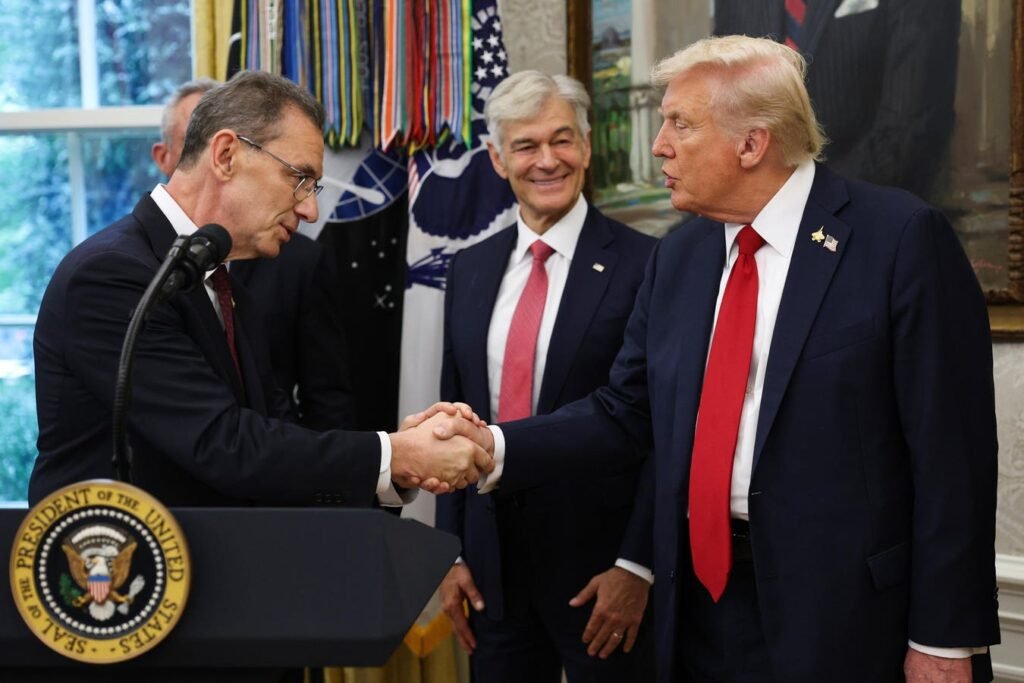WASHINGTON, DC: U.S. President Donald Trump shakes hands with Pfizer CEO Albert Bourla in the Oval Office of the White House as he announces a deal with Pfizer to lower drug prices on September 30, 2025. (Photo by Win McNamee/Getty Images)
Getty Images
Pfizer and AstraZeneca’s recent drug-pricing deals with the Trump Administration mark a significant shift in Washington’s approach to the pharmaceutical industry. Faced with potential 100% tariffs, both companies agreed to lower prices and increase U.S. investment under a new framework that links affordability to domestic production.
Pharmaceutical leaders should view this as more than just a one-time concession but as a fundamental change. Each company must develop its own strategy based on its portfolio, data, and competitive position to navigate a market that now emphasizes defining and communicating value.
In July, President Trump sent letters to 17 leading pharmaceutical manufacturers, giving them 60 days to propose plans to reduce U.S. drug prices, a topic I recently discussed in a column.
The White House’s four-point directive outlined a specific framework to address the long-standing imbalance in global drug pricing, where Americans pay, on average, three times what consumers in other developed countries pay.
Manufacturers were instructed to offer Medicaid patients prices equivalent to the lowest rates available in any other developed market. They were also asked to ensure that new drugs are priced equally in the United States and other developed nations. Additionally, they were encouraged to establish direct-to-consumer sales channels, like the upcoming TrumpRx.gov, to allow patients to purchase medicines at discounted international prices. Finally, manufacturers were advised to reinvest any profits from higher international prices into making drugs more affordable for American patients and taxpayers.
The letter made it clear that if the industry did not act, the administration would use all available tools to bring about change. While this approach falls short of traditional price controls, it leverages economic power to achieve a similar goal: reducing prices through negotiation and transparency rather than imposing set price limits.
Importantly, it gives each manufacturer the opportunity to create its own plan of action. The optimal strategy for a company will depend on its product mix, relationships with payers, and data assets.
Pfizer was the first to respond, agreeing in late September to meet all four requirements. The company committed to offering its primary care and specialty drugs at discounts averaging 50%, with some discounts as high as 85%. It also pledged to price new drugs similarly to peer nations and extend these terms to Medicaid, Medicare, and commercial payers.
In exchange, Pfizer received a three-year exemption from pharmaceutical-specific tariffs, contingent on a $70 billion investment in domestic manufacturing and research and development. CEO Albert Bourla described the agreement as providing “certainty and stability on two critical fronts, tariffs and pricing.”
AstraZeneca’s agreement, announced two weeks later, followed a similar model but with a different focus. The company agreed to offer “most-favored-nation” pricing to Medicaid and equal pricing for newly launched drugs. It also committed to a $50 billion investment in the U.S., including a $4.5 billion manufacturing facility in Virginia expected to create over 3,000 jobs. CEO Pascal Soriot acknowledged that tariffs played a significant role in the company’s decision to negotiate.
The Trump Administration’s use of tariffs as leverage represents a unique approach to economic policy—a willingness to drive change by compelling stakeholders to come to the table rather than dictating specific solutions. It challenges pharmaceutical companies to justify their pricing with evidence.
To justify price differences across markets, manufacturers must demonstrate patient-relevant outcomes at a lower total cost. This process is likely to push companies to invest more in analytics, real-world evidence, and long-term studies that demonstrate true value. Companies that can support their claims with evidence will have negotiating power, while those that cannot will not.
In this sense, the administration’s pressure could lead to an unintended but positive outcome: an industry that is more rigorous in linking price to performance and better able to communicate value to payers and the public.
The agreements with Pfizer and AstraZeneca signal the start of a new era in pharmaceutical negotiations. They demonstrate an administration committed to using leverage to realign global pricing, reward domestic investment, and demand measurable value from one of America’s most critical industries.
With the administration’s assertive tactics, pharmaceutical companies cannot avoid this reckoning, but they can influence how it unfolds by negotiating deals that benefit their company. The alternative is to relinquish that control to policymakers who may prefer more rigid approaches.
Companies that engage constructively now will be better positioned to shape the future of value in healthcare on terms that balance innovation, transparency, and national interest.


